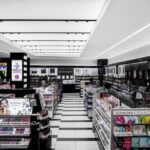The Wall Street Journal reports that “retailers are on track to open 1,000 net new stores in the U.S. this year as retail availability hits record lows, in fresh signs of the sector’s resilience despite turmoil in commercial real estate.
“Landlords say demand for retail space has remained robust this year, defying inflation pressures, high interest rates and liquidations including Bed Bath & Beyond and Christmas Tree Shops.”
The trend contradicts conventional wisdom that e-commerce would supplant physical commerce; instead, the Journal writes, “digitally native companies are opening bricks-and-mortar locations after reaching the limits of online customer acquisition.”
Conventional wisdom also suggested that the US was over-stored, but that seems not to matter at the moment. In fact, retailers have “started using online sales data and analytics technology to pinpoint locations for successful stores.” At the same time, “Shoppers flocked back to stores and restaurants as pandemic restrictions eased.”
Some context from the Journal story:
“As of mid-August, retailers had announced plans to open nearly 4,500 new locations while shutting about 3,500, according to advisory and research firm Coresight Research. Nationwide, the rate of available retail space fell to 4.8% in the second quarter, the lowest level in the 18 years the data has been tracked by real-estate-services firm CBRE.
“The retail real-estate recovery stands in contrast to the office market, where the popularity of hybrid work schedules has helped push up the office-vacancy rate to a 30-year high of 18.2%, according to CBRE … Shopping-center owners, particularly in the suburbs, have benefited from the rise of remote work since the onset of Covid-19 in 2020, as consumers visit local grocery stores and other shops more often during the workweek. In response, some fast-casual restaurants and other retailers have shifted from urban business districts to the suburbs.”
KC’s View:
I’m not sure I’ve ever believed that physical retail would be made obsolete by e-commerce. It always seemed clear to me that while there was some shifting taking place, compelling shopping experiences – whether digital or physical – would be successful. (I still think that the most endangered shopping experiences are those that are mediocre and non-differentiated.)
I did not foresee that the pre-pandemic urbanization trend – people getting married later in life, having fewer kids, moving back to staying in cities and needing smaller abodes and not even needing to own cars – would not play out as many of us expected. Blame the pandemic – suddenly, living and working in places with green spaces and less crime/homelessness seemed like. a pretty good deal, and suburbs (and exurbs and what are called “donut cities”) were a lot more appealing.
It is in these latter places that the real retail opportunity exists – serving people who want the products and services and amenities more typical of urban environments even as they live in places other than cities. And I think that, to at least some extent, may account for the physical retail growth.
The post Retail A Bright Spot In Commercial Real Estate Landscape appeared first on MNB.
View Original Article


